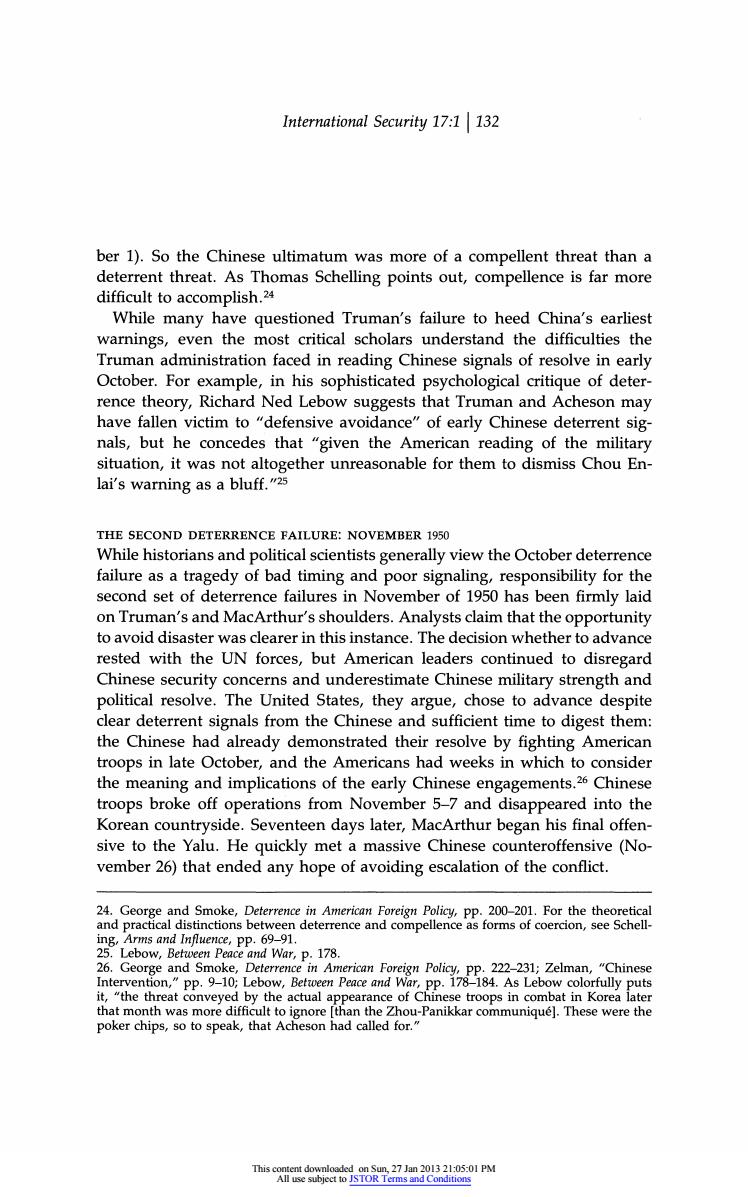正在加载图片...

International Security 17:1 132 ber 1).So the Chinese ultimatum was more of a compellent threat than a deterrent threat.As Thomas Schelling points out,compellence is far more difficult to accomplish.24 While many have questioned Truman's failure to heed China's earliest warnings,even the most critical scholars understand the difficulties the Truman administration faced in reading Chinese signals of resolve in early October.For example,in his sophisticated psychological critique of deter- rence theory,Richard Ned Lebow suggests that Truman and Acheson may have fallen victim to "defensive avoidance"of early Chinese deterrent sig- nals,but he concedes that "given the American reading of the military situation,it was not altogether unreasonable for them to dismiss Chou En- lai's warning as a bluff."25 THE SECOND DETERRENCE FAILURE:NOVEMBER 1950 While historians and political scientists generally view the October deterrence failure as a tragedy of bad timing and poor signaling,responsibility for the second set of deterrence failures in November of 1950 has been firmly laid on Truman's and MacArthur's shoulders.Analysts claim that the opportunity to avoid disaster was clearer in this instance.The decision whether to advance rested with the UN forces,but American leaders continued to disregard Chinese security concerns and underestimate Chinese military strength and political resolve.The United States,they argue,chose to advance despite clear deterrent signals from the Chinese and sufficient time to digest them: the Chinese had already demonstrated their resolve by fighting American troops in late October,and the Americans had weeks in which to consider the meaning and implications of the early Chinese engagements.26 Chinese troops broke off operations from November 5-7 and disappeared into the Korean countryside.Seventeen days later,MacArthur began his final offen- sive to the Yalu.He quickly met a massive Chinese counteroffensive (No- vember 26)that ended any hope of avoiding escalation of the conflict. 24.George and Smoke,Deterrence in American Foreign Policy,pp.200-201.For the theoretical and practical distinctions between deterrence and compellence as forms of coercion,see Schell- ing,Arms and Influence,pp.69-91. 25.Lebow,Between Peace and War,p.178. 26.George and Smoke,Deterrence in American Foreign Policy,pp.222-231;Zelman,"Chinese Intervention,"pp.9-10;Lebow,Between Peace and War,pp.178-184.As Lebow colorfully puts it,"the threat conveyed by the actual appearance of Chinese troops in combat in Korea later that month was more difficult to ignore [than the Zhou-Panikkar communique].These were the poker chips,so to speak,that Acheson had called for." This content downloaded on Sun,27 Jan 2013 21:05:01 PM All use subject to JSTOR Terms and ConditionsInternational Security 17:1 | 132 ber 1). So the Chinese ultimatum was more of a compellent threat than a deterrent threat. As Thomas Schelling points out, compellence is far more difficulto accomplish.24 While many have questioned Truman's failure to heed China's earliest warnings, even the most critical scholars understand the difficulties the Truman administration faced in reading Chinese signals of resolve in early October. For example, in his sophisticated psychological critique of deterrence theory, Richard Ned Lebow suggests that Truman and Acheson may have fallen victim to "defensive avoidance" of early Chinese deterrent signals, but he concedes that "given the American reading of the military situation, it was not altogether unreasonable for them to dismiss Chou Enlai's warning as a bluff. "25 THE SECOND DETERRENCE FAILURE: NOVEMBER 1950 While historians and political scientists generally view the October deterrence failure as a tragedy of bad timing and poor signaling, responsibility for the second set of deterrence failures in November of 1950 has been firmly laid on Truman's and MacArthur's shoulders. Analysts claim that the opportunity to avoid disaster was clearer in this instance. The decision whether to advance rested with the UN forces, but American leaders continued to disregard Chinese security concerns and underestimate Chinese military strength and political resolve. The United States, they argue, chose to advance despite clear deterrent signals from the Chinese and sufficientime to digest them: the Chinese had already demonstrated their resolve by fighting American troops in late October, and the Americans had weeks in which to consider the meaning and implications of the early Chinese engagements.26 Chinese troops broke off operations from November 5-7 and disappeared into the Korean countryside. Seventeen days later, MacArthur began his final offensive to the Yalu. He quickly met a massive Chinese counteroffensive (November 26) that ended any hope of avoiding escalation of the conflict. 24. George and Smoke, Deterrence in American Foreign Policy, pp. 200-201. For the theoretical and practical distinctions between deterrence and compellence as forms of coercion, see Schelling, Arms and Influence, pp. 69-91. 25. Lebow, Between Peace and War, p. 178. 26. George and Smoke, Deterrence in American Foreign Policy, pp. 222-231; Zelman, "Chinese Intervention," pp. 9-10; Lebow, Between Peace and War, pp. 178-184. As Lebow colorfully puts it, "the threat conveyed by the actual appearance of Chinese troops in combat in Korea later that month was more difficulto ignore [than the Zhou-Panikkar communique]. These were the poker chips, so to speak, that Acheson had called for." This content downloaded on Sun, 27 Jan 2013 21:05:01 PM All use subject to JSTOR Terms and Conditions